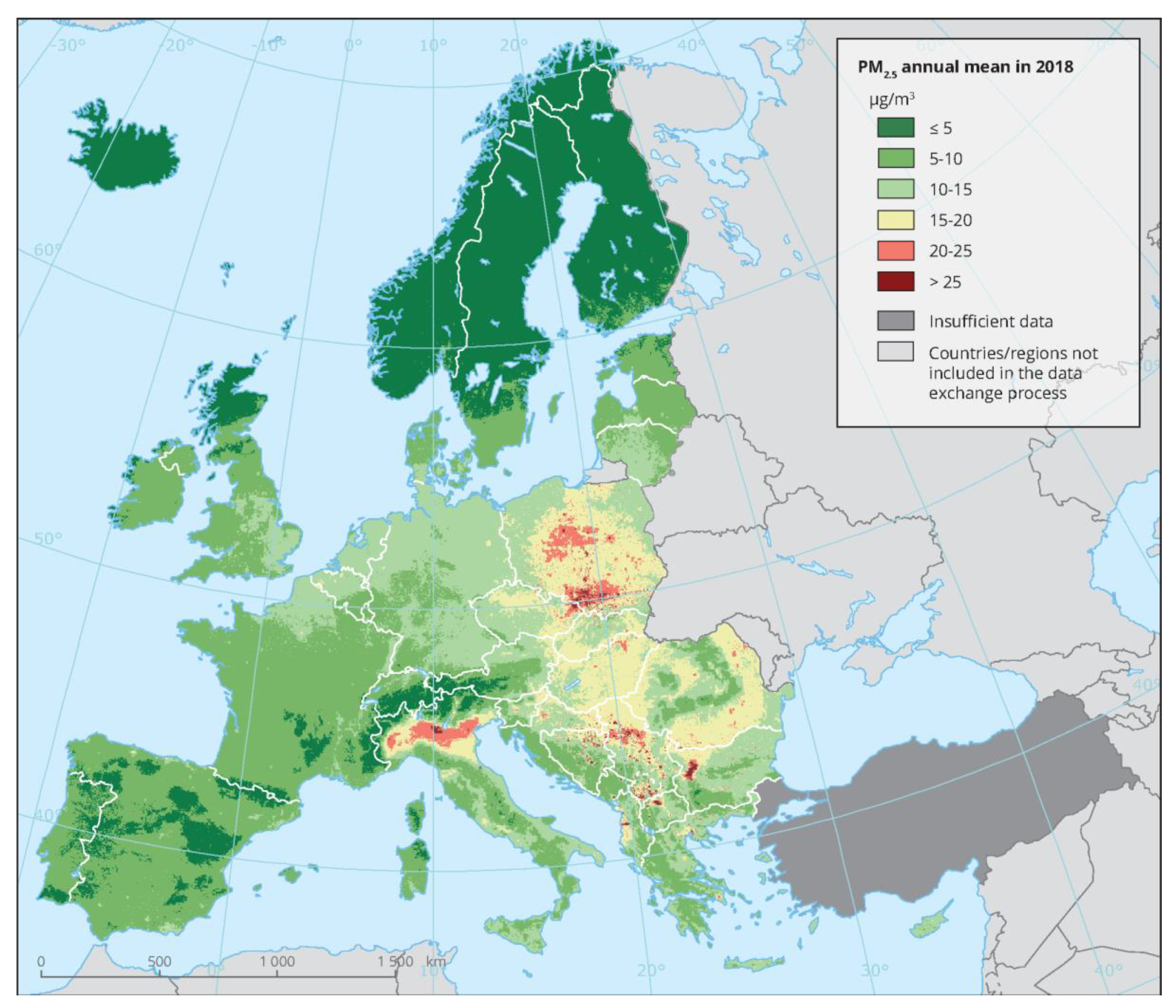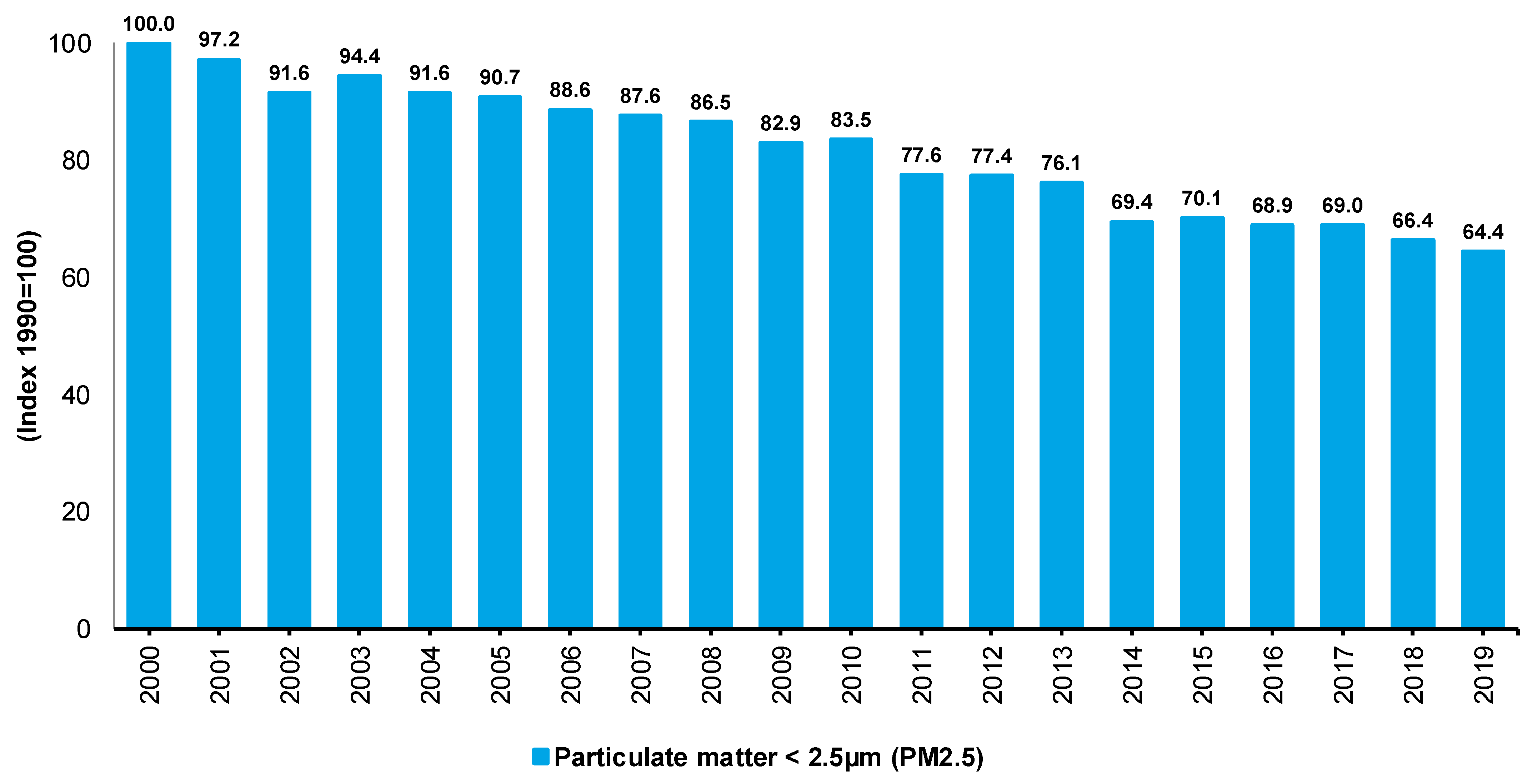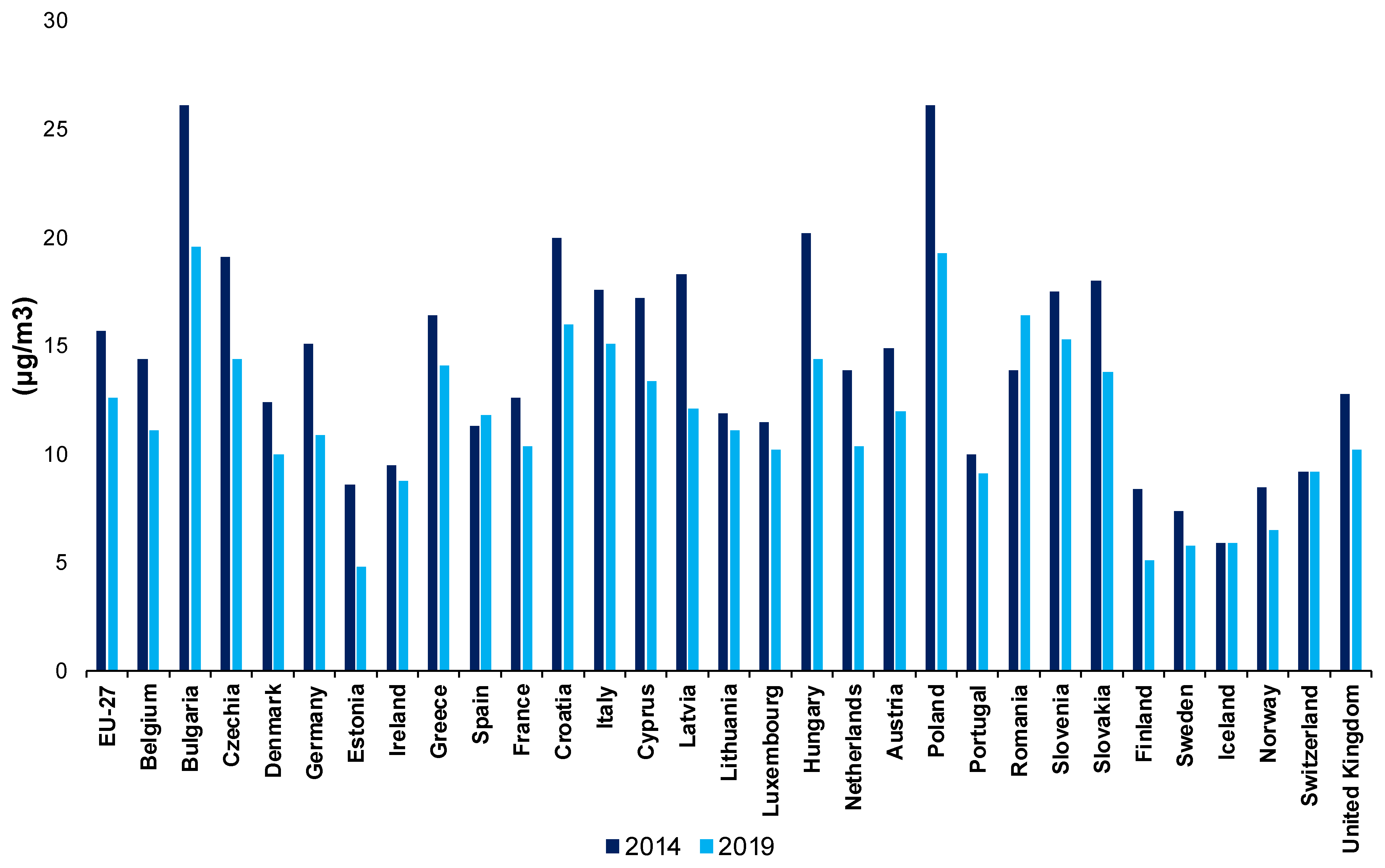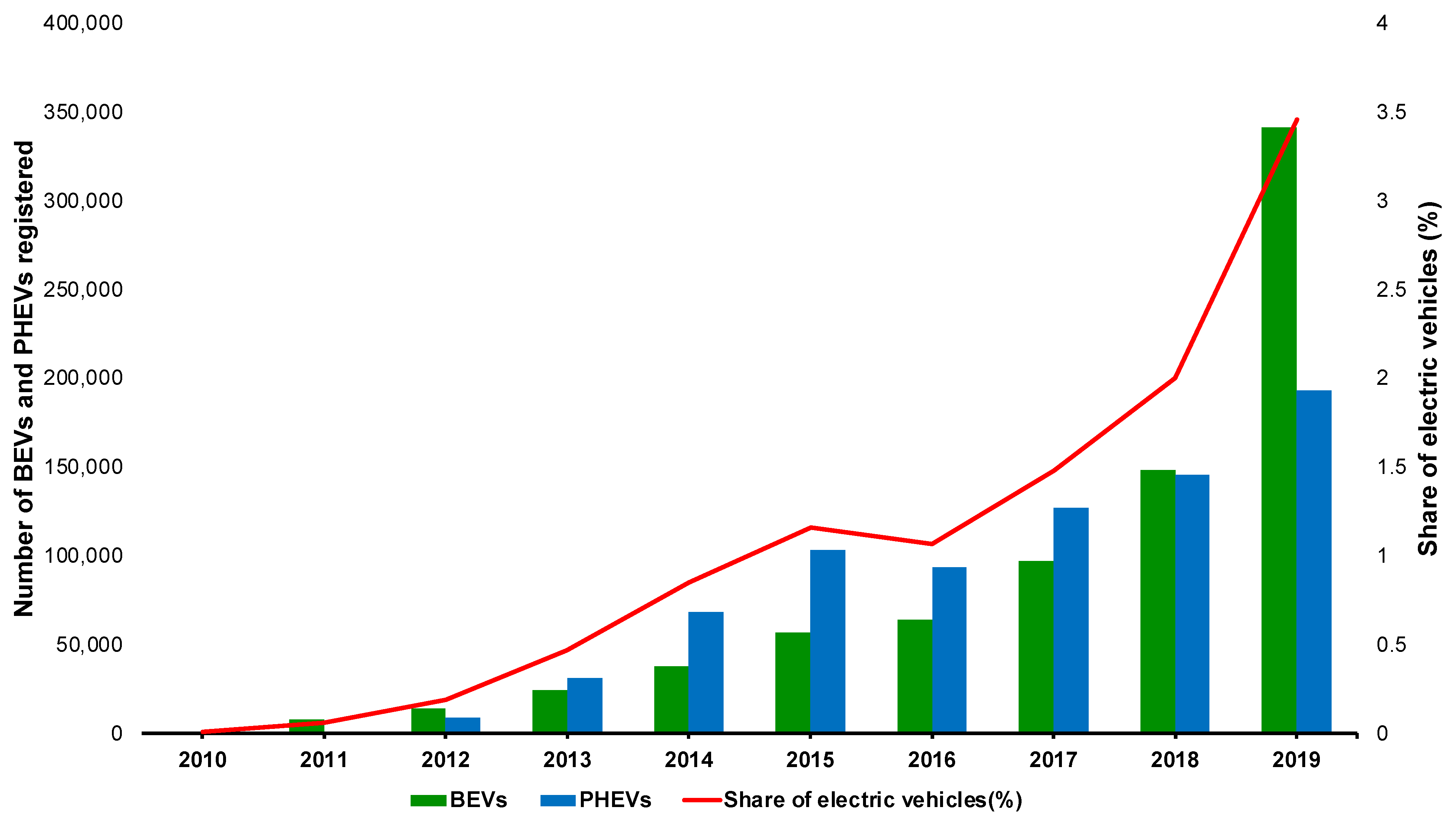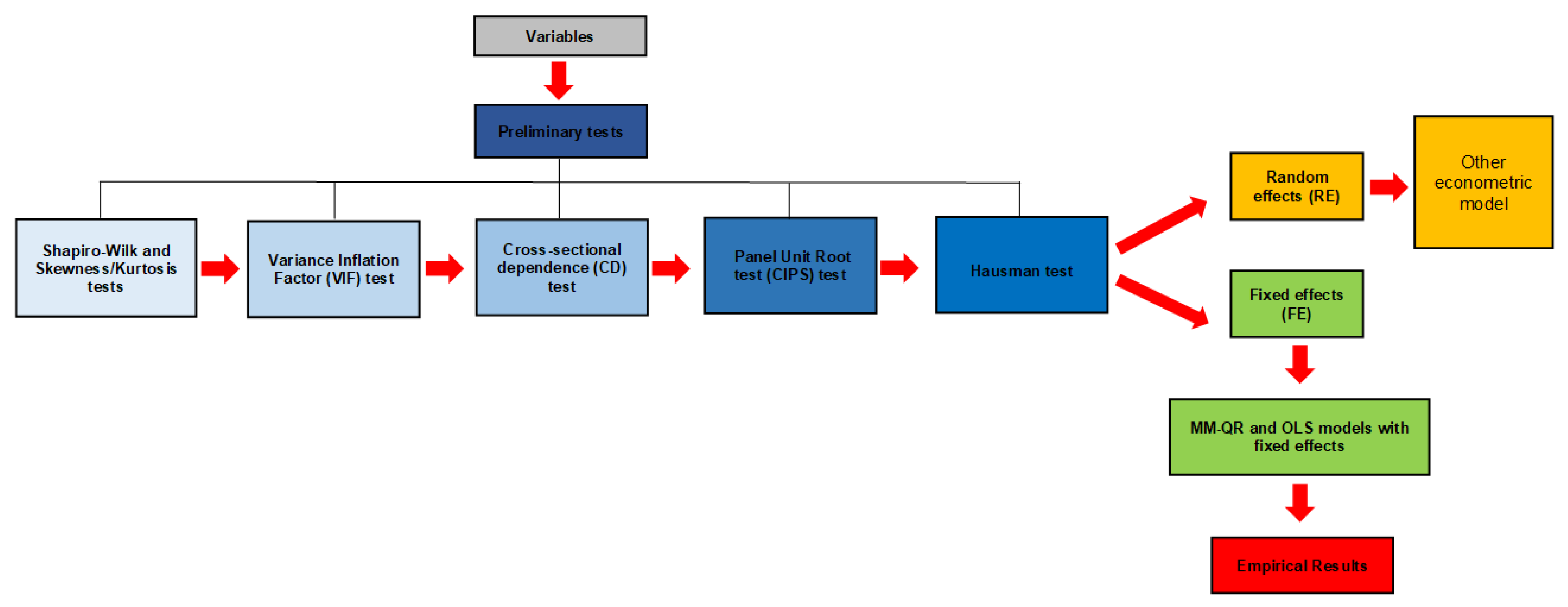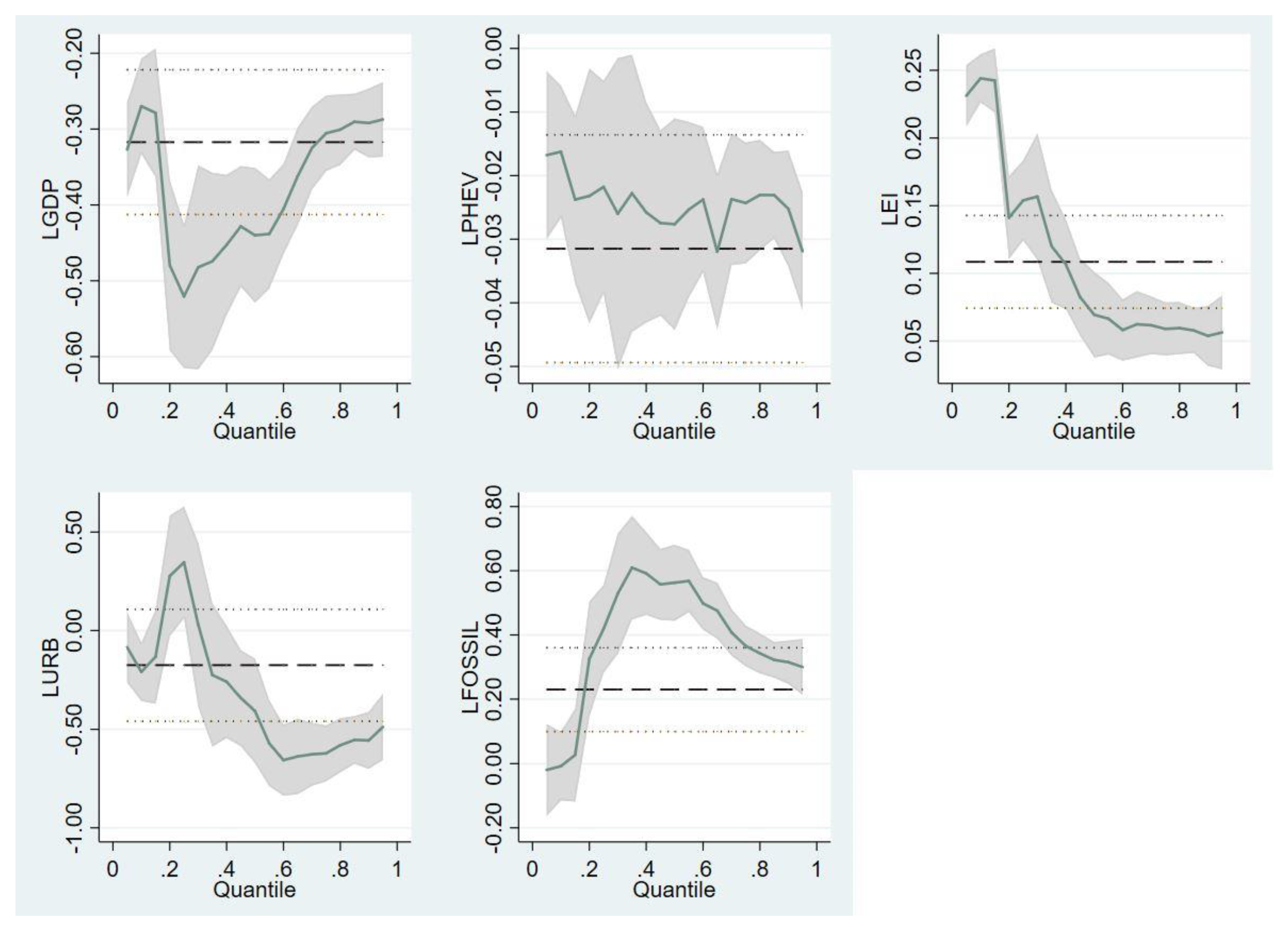1. Introduction
Many cities suffer from poor air quality in Europe. As a result, they frequently exceed the European Union’s (EU) Air Quality Framework Directive 96/62/EC and its daughter directives and guidelines recommended by the World Health Organization (WHO). This issue is fine particulate matter (PM1.0), for which the daily rate of 50 µg/m
3 is not to be exceeded on more than 35 days a year. Indeed, in the many cities and regions in Europe, the yearly average limit values (40 µg/m
3) are often exceeded [
1]. However, the minimum threshold of particulate matter below which there are no adverse health effects could not be established. The WHO guidelines represent global targets (for both industrialised and developing countries) above which increased mortality responses because of particulate matter air pollution are expected based on current scientific findings (e.g., Thunis et al. [
1] and WHO [
2]). In the case of particulate matter (PM2.5), the EU limited value is an annual average of 25 µg/m
3 [
1]. This target was established through Ambient Air Quality Directive 2008/50/EC that settled particulate matter (PM2.5) [
3]. However, few cities across the EU have managed to keep concentrations below the WHO’s recommended level (10 µg/m
3 on an annual basis), as illustrated in
Figure 1.
In the EU, the PM2.5 emissions have decreased to about two-thirds of their 2000 levels (as shown in
Figure 2). The timeline of emissions reductions shows that the EU-27 as a whole is on track to achieve the reduction target set by the National Emission Ceilings Directive (NECD). Moreover, the NECD set emission ceilings for 2010 and for PM2.5 emissions and emissions reduction commitments for 2020 and 2030.
Therefore, in 2000 the PM2.5 emissions were 1,726,970 Gg (1000 tonnes) and in 2019 reached a value of 1,111,440 Gg (1000 tonnes). That is a reduction to about two-thirds (64.4%) of 2000 levels between 2000–2019. The country-specific PM2.5 timelines suggest that four countries (Bulgaria, Poland, Romania, and Croatia) cannot meet their commitments by 2020 (as shown in
Figure 3).
As exposed in
Figure 3, the annual mean concentration of PM2.5 is highest in 2019 in the urban areas of Bulgaria (19.6 μg/m
3) and Poland (19.3 μg/m
3), followed by Romania (16.4 μg/m
3) and Croatia (16 μg/m
3). Therefore, these countries may need to implement emission reduction measures beyond those currently in place. In contrast, the average value for the EU-27 is 12.6 μg/m
3, and in some countries of the EU, the concentration of PM2.5 is lowest in urban areas. This is the case in Estonia (4.8 μg/m
3), Finland (5.1 μg/m
3), and Sweden (5.8 μg/m
3). In these countries, the mean of PM2.5 air pollution in 2019 continued with high levels, that were above the WHO recommended levels. Although this type of air pollution has for several years been below the limit set for 2015 (25 μg/m
3 annual average), substantial air pollution hotspots remain. Additionally, despite a gradual decrease in recent years, air pollution levels in 2019 remain above the WHO recommended level (10 μg/m
3 annual average).
These emissions in the EU come from the commercial, institutional, and households’ sector (55.49%), industrial processes and product use sector (11.98%), road transport sector (10.67%), energy use in the industry sector (8.15%), energy production and distribution sector (3.87%), waste sector (3.80%), no-road transport sector (2.69%), agriculture sector (3.31%), and other (0.04%) (as shown in
Figure 4).
The contribution of 11% from the road transport sector indicates that current transport systems based on conventional vehicles are unsustainable from an environmental, health, social, and economic perspective [
7]. Indeed, from a health perspective, the increase of PM2.5 emissions caused by vehicular emissions has adverse health effects and may cause premature deaths. Moreover, according to Thunis et al. [
1], exposure to PM2.5 is responsible for an average loss of life of about 8 to 10 months in the most polluted regions and cities of the EU. Therefore, electric vehicles, which include battery electric vehicles (BEVs) and plug-in hybrid electric vehicles (PHEVs), are widely considered as a solution to many of the negative impacts of their conventional counterparts [
7]. Furthermore, given their potential to reduce local air pollution and greenhouse gas emissions, consumers, businesses, and governments increasingly support electric vehicles [
8].
The main objective of this research is to identify the effect of electric vehicles (e.g., BEVs and PHEVs) on PM2.5 in European countries. As we already know, BEVs are purely electric vehicles that exclusively use chemical energy stored in rechargeable batteries, with no secondary source of propulsion. Therefore, this type of vehicle does not emit exhaust emissions. Furthermore, the adoption of these vehicles is generally seen as a highly effective measure to improve air quality [
7]. PHEVs are hybrid electric vehicles whose battery can be recharged by connecting a charging cable to an external electrical power source and internally by the onboard generator an internal combustion engine. They emit exhaust emissions in a reduced form when compared to internal combustion engine vehicles (ICEVs) [
7].
In the European region, BEVs and PHEVs are gradually penetrating the market. However, despite a steady increase in the number of new electric vehicle registrations (BEVs and PHEVs) annually, from 734 units in 2010 to around 534,583 units in 2019, they still represent a market share of only 3.5% of newly registered passenger vehicles. BEVs accounted for 2.2% of all newly registered vehicles in 2019, representing about two-thirds of electric car sales, while PHEVs accounted for 1.3% (as shown in
Figure 5).
As shown in
Figure 5, the number of new electric cars registered in the EU is increasing. In fact, more than half of these registrations were made in Germany, Norway, the Netherlands, France, and the United Kingdom (e.g., EEA [
9]). Indeed, in some countries in Europe (e.g., Cyprus, Estonia, Greece, Lithuania, Slovakia, and Slovenia), the number of BEVs in the total number of registered vehicles remained below 200 units in 2019. However, between 2018 and 2019, a notable increase (129%) in new registrations was registered. This increase can be partly explained by the inclusion of Norway in the dataset in 2019, a country that registered about 60,000 electric cars [
9]. In fact, regarding the total number of electric vehicles in the fleet, the number of BEVs in 2010 was 734, and in 2020 reached 720,913. The total number of PHEVs was 9000 in 2012 and reached a value of 603,314 in 2020. Germany, Norway, the United Kingdom, France, and the Netherlands are the top 5 countries with a significant number of BEVs and PHEVs in the EU in 2020, while Liechtenstein, Cyprus, and Latvia are countries with fewer BEVs and PHEVs in the fleet in the region [
9].
Furthermore, in Germany, the number of registered BEVs in the fleet was 308,139, while the number of PHEVs was 287,037 in 2020. In Norway, the number of registered BEVs in the fleet was 319,540 and PHEVs was 134,420. In the United Kingdom, the number of registered BEVs in the fleet was 206,998 and PHEVs was 240,631. In France, the number of registered BEVs in the fleet was 277,001 and PHEVs was 132,309. Furthermore, in the Netherlands, the number of registered BEVs in the fleet was 172,534 and PHEVs was 100,371 [
9].
Although increasing the market share of BEVs and PHEVs could help the EU meet its emission reduction targets and ensure progress towards its long-term climate neutral strategy by 2050, their implications for PM2.5 emissions remain less understood. This vision is shared by Requia et al. [
8]. The authors assessed 4734 studies on the impact of a shift to greater electric car (BEVs and PHEVs) use. Of the 65 studies that fulfilled the inclusion criteria for the review, the authors concluded that while the benefits of electric cars concerning the exhaust emissions of several air pollutants are well-established, less evidence exists regarding the impact of electric car use on PM2.5 emissions.
As mentioned above, few studies exist that analyse the effect of BEVs and PHEVs on PM2.5 emissions. Most of them are related to and studied by the field of engineering. Studies of this topic do not relate to macroeconomics or use econometrics. This scarcity allows us to conclude that a gap exists in economic theory on the impact of electric vehicles on PM2.5 emissions.
Of the few studies in technologies and engineering, most have shown that electric vehicles improve the environment and reduce PM2.5 emissions, CO
2 emissions, and greenhouse emissions by assessing the life cycle of electric cars, with a particular focus on BEVs and PHEVs (e.g., Rangaraju et al. [
10]; Timmers and Achten [
11]; Alam et al. [
12]; Vilchez et al. [
13]; Xiong et al. [
14]; Ajanovic and Haas [
15]; Wang et al. [
16]; Vilchez and Jochem [
17]; Wang et al. [
18]; Andersson and Börjesson [
19]; Zhao et al. [
20]; and Ma et al. [
21]).
Faced with a lack of literature that addresses the effect of electric vehicles (e.g., BEVs and PHEVs) on PM2.5 emissions in European countries using a macroeconomic and econometric approach, this investigation elaborates on the following central question: Can BEVs and PHEVs mitigate the PM2.5 emissions in European countries? To answer this central question, an empirical analysis was performed. This analysis was based on the macroeconomic panel data of 29 European countries between 2010 and 2019. Moreover, the method of moments quantile regression (MM-QR) and ordinary least squares (OLS) with fixed effects will be used.
This empirical investigation is innovative and will contribute to the literature for several reasons. First, by introducing a new analysis related to the effect of electric vehicles on PM2.5 emissions in the European countries. Moreover, economists do not usually investigate this issue, and this study can open new opportunities for study related to this topic using an econometric and macroeconomic approach. Therefore, this makes our study innovative when compared with others. Second, this investigation will introduce new econometric models to this topic of investigation (e.g., MM-QR and OLS with fixed effects). It can also be considered innovative because of the use of a new econometric approach on a new case study. Finally, this investigation will support policymakers in developing consistent initiatives that promote the development and commercialisation of electric vehicles in European countries. Moreover, it will also help to create more policies to reduce the consumption of fossil fuels to mitigate environmental degradation.
This investigation is divided into seven sections, as follows:
Section 2 will present the literature review;
Section 3 will present the data and methods;
Section 4 will present the empirical results;
Section 5 will present the discussions of the results that were found;
Section 6 will present the conclusions and policy implications; and
Section 7 will present the limitations of this study.
3. Data and Method
As mentioned before, this section will present the data and methods used to carry out this empirical investigation. Therefore,
Section 3.1 will present the data/variables that will be used, and
Section 3.2 will present the methods.
3.1. Data
In order to carry out this empirical investigation, data were collected from 29 countries from the European region between 2010 and 2019. The European countries that were selected are Austria, Belgium, Bulgaria, Croatia, Cyprus, Czechia, Denmark, Estonia, Finland, France, Germany, Greece, Hungary, Iceland, Ireland, Italy, Latvia, Lithuania, Luxembourg, the Netherlands, Norway, Poland, Portugal, Romania, Slovakia, Slovenia, Spain, Sweden, and the United Kingdom.
These 29 countries were selected because electric vehicles are gradually penetrating the European market. However, the number of new electric vehicle registrations (BEVs and PHEVs) annually, from 734 units in 2010 to about 534,583 units in 2019, still accounts for a market share of only 3.5% of newly registered passenger vehicles. BEVs accounted for 2.2% of total new car registrations in 2019, representing around two-thirds of electric car sales, while PHEVs represented 1.3% [
9]. As this investigation will address a macroeconomic aspect, it is convenient to use all countries from the European region. Moreover, this investigation used data from 2010 to 2019 because the OECD data provides data until 2019 for the variable PM2.5, and the EAFO [
40] provides data beginning in 2010 for the variables BEVs and PHEVs. Therefore, the variables selected to carry out this empirical investigation will be shown in
Table 1. Indeed, this table shows the variable definitions and the sources of variables.
This investigation will use the following variables: PM2.5, BEVs, PHEVs, EI, GDP, URB, and FOSSIL. PM2.5 is our dependent variable, while BEVs, PHEVs, EI, GDP, URB, and FOSSIL are our independent variables. Moreover, EI, GDP, URB, and FOSSIL are the control variables. Therefore, after presenting the variables, it is also necessary to present the methods used in this empirical investigation.
3.2. Methods
As mentioned before, this subsection presents the methods used in this empirical investigation. Therefore, this subsection will present the MM-QR and OLS with fixed effects models and the preliminary tests.
3.2.1. MM-QR Model
This study adopted the MM-QR approach for panel fixed effects as the main method to explore the impact of electric vehicles on PM2.5 emissions in European countries. Machado and Silva [
44] developed this model. Moreover, according to Usman et al. [
45], this method can capture the unobserved distributional heterogeneity across countries within a panel. Fuinhas et al. [
46] point out that the MM-QR method has other advantages. According to the authors, this method assumes that the covariate affects only the variables of interest through the location channel. Moreover, the same authors state that this method also assumes that the covariate affects only the variables of interest through the scale functions relative to a mere shifting. Moreover, this method can examine the conditional heterogenous covariance effects of the determinants of PM2.5 emissions at different quantiles [
44].
The typical definition of MM-QR can be presented as the following (Equation (1)):
where the scalar coefficient
denotes the quantile-
fixed effects for an individual country. The distributional impact varies from the classical fixed effect, given that it is not location fixed [
46]. Moreover, Machado and Silva [
44] state that the distribution impact depicts the time-invariant traits that allow other variables to have diverse effects on investigated countries.
3.2.2. OLS with Fixed Effects Model
According to Fuinhas et al. [
46], the OLS with fixed effects can estimate the slope and intercepts for a set of observations. Moreover, the same authors state that this model can estimate the mean response for the fixed predictors (see Equation (2)).
where
β0 is the intercept and
β is the value of fixed covariates being fitted to predict the dependent variable
LPM2.5it,
εi is the error term, and each variable enters regression for country
i at year
t.
Indeed, before realising model estimations, it is necessary to carry out the preliminary tests. Therefore, the following subsection will illustrate the initial tests used in this empirical analysis.
3.2.3. Preliminary Tests
The preliminary tests need to be carried out before the MM-QR and OLS model estimations. The preliminary tests are necessary to identify the characteristics of variables and the existence of singularities. Indeed, a lack of preliminary tests could lead to inconsistent and improper interpretations [
47]. Therefore, the following tests will be done:
- (I)
Shapiro-Wilk [
48]. This test checks the presence of normality in the panel model;
- (II)
Skewness/Kurtosis [
49]. This test checks the presence of normality in the panel model;
- (III)
Variance Inflation Factor (VIF) [
50]. This test identifies the presence of multicollinearity between the variables of the model;
- (IV)
Cross-sectional dependence (CD) [
51]. This test checks the presence of cross-sectional dependence in the variables of the model;
- (V)
Panel Unit Root test (CIPS) [
52]. This test verifies the presence of unit roots in the variables;
- (VI)
Hausman [
53]. This test verifies the random effects vs fixed effects and identifies heterogeneity.
Therefore, this investigation will follow the following conceptual framework, highlighting the methodological approach used (as shown in
Figure 6).
The econometric software Stata 17.0 was used to carry out this empirical investigation. Moreover, the Stata commands, such as sum, sktest, swilk, vif, xtcd, multipurt, hausman, xtqreg, and xtreg will be used to realise the preliminary tests and model estimations. The following section will present the empirical results of this study.
5. Discussions
As presented in the section above, the variables LGDP, LBEVs, LPHEVs, and LURB negatively impact PM2.5 emissions, while the variables LEI and LFOSSIL have a positive impact. In light of these findings, this investigation produced the following questions: What are the possible explanations for the results found? Several authors found the negative impact of GDP on PM2.5 emissions (e.g., Wu et al. [
27]; Wang et al. [
33]; Wang et al. [
34]; Zhang et al. [
35]; and Zhu et al. [
36]). According to Wang et al. [
33], the negative impact of GDP on PM2.5 emissions could be related to a lower dependence on fossil fuels. This idea also is supported by Wu et al. [
27]. However, according to the authors, the lower dependence on fossil fuels for growth is related to an increase in income per capita that allows for the development and accessing of new technologies with high energy efficiency and green energy technologies by industries and households.
Moreover, Wang et al. [
34] state that the increase in income allows for technique improvements through the access of new technologies. Therefore, this improvement allows for less input per unit of output or for the adoption of cleaner production technologies. Therefore, the pollution per unit of output decreases. The same authors add that high-income countries pursue policies focused on achieving stringent environmental standards and innovations to create cleaner energy utilisation, thereby decreasing emissions. Therefore, these aspects allow a negative U-shaped relationship between GDP and PM2.5 emissions in developed countries, as found in this investigation (as shown in
Figure 8 and
Figure 9).
The negative impact of electric vehicles (e.g., BEVs and PHEVs) on PM2.5 emissions were found by several authors (e.g., Rangaraju et al. [
10]; Timmers and Achten [
11]; Alam et al. [
12]; Vilchez et al. [
13]; Xiong et al. [
14]; Ajanovic and Haas [
15]; Wang et al. [
16]; Vilchez and Jochem [
17]; Wang et al. [
18]; Andersson and Börjesson [
19]; Zhao et al. [
20]; and Ma et al. [
21]). According to Ajanovic and Haas [
15], electric vehicles (e.g., BEVs and PHEVs) can mitigate environmental degradation. However, this mitigation depends on the form of production and use of electric vehicles. The authors conclude that the capacity of electric vehicles to mitigate environmental degradation depends on renewable electricity use, and Vilchez and Jochem [
17] share this idea. According to the authors, electric cars can mitigate air pollution if the vehicles use electricity from green energy sources.
Xiong et al. [
14], who studied the Chinese case, agreed with the visions of Vilchez and Jochem [
17] and Ajanovic and Haas [
15]. According to the authors, electric cars decrease CO
2 emissions by reducing energy consumption. This view that electric vehicles can reduce energy consumption is supported by Fuinhas et al. [
46] and the European Environment Agency [
9]. They reveal that the energy consumption from electric vehicles decreased from 264 Wh/km to 150 Wh/km. This result is an indication that electric cars have become more efficient. Moreover, Nielsen and Jørgensen [
58] predicted that electric cars would consume less energy. According to the authors, the energy consumption from electric vehicles will be 0.10 kWh/km between 2016 and 2030.
The evidence that electric cars consume less energy in the European region was found by Fuinhas et al. [
46] and Koengkan et al. [
59]. According to Fuinhas et al. [
46], electric vehicles reduce the final energy consumption by -0.0154. Therefore, Fuinhas et al. [
46] confirm the evidence that electric cars consume less energy, as mentioned by Ajanovic and Haas [
15] and Vilchez and Jochem [
17]. Indeed, according to the European Environment Agency [
9], this reduction is related to the increase in the energy efficiency of vehicles. However, despite the capacity of electric cars (e.g., BEVs and PHEVs) to mitigate PM2.5 emissions, their impact is small. Indeed, this small impact is related to the low share of electric cars on the market, where this kind of vehicle had 3.5% in 2019 in Europe [
9].
Several authors found the negative impact of urbanisation on PM2.5 emissions (e.g., Wu et al. [
27]; Wang et al. [
33]; Wang et al. [
34]; Zhang et al. [
35]; and Zhu et al. [
36]). Wang et al. [
34] point out that the negative impact of urbanisation on PM2.5 emissions could result from the rapid urbanisation process transforming the economies. Urbanisation results in remarkable improvements in urban infrastructure and software facilities. These attract talent to gather in urban areas, contributing to human capital accumulation. Human capital accumulation enhances environmental awareness and promotes the R&D of energy-saving and abatement technologies. Therefore, PM2.5 pollution intensity gradually decreases as the levels of urbanisation increase. The same authors complement that the urbanisation development provides the opportunity for investing in information-based industries and services.
Furthermore, it also improves production techniques or adopts cleaner technology. These impacts are called the composition and technique effects, and they can surpass the scale effect and produce a downward trend in the EKC curve. Other authors share this point of view (e.g., Wu et al. [
27]; Wang et al. [
33]; Zhang et al. [
35]; and Zhu et al. [
36]).
Finally, regarding the positive impact of energy intensity and fossil energy consumption on PM2.5 emissions, several authors have found this effect (e.g., Cheng et al. [
25]; Xu and Lin [
26]; Wu et al. [
27]; Zhao et al. [
28]; Chen et al. [
29]; Yang et al. [
31]; Xie and Sun [
32]; Wang et al. [
34]; Zou and Shi [
38]; Soleimani et al. [
39]; and Zhang et al. [
35]). For Wang et al. [
34], the positive impact of energy intensity on PM2.5 emissions is related to the high participation of non-renewable energy on the energy matrix. According to Fuinhas et al. [
46], in 1990, 71% of the final energy consumption came from non-renewable energy sources (e.g., solid fossil fuels, crude oil, petroleum products, and natural gas), while renewable energy sources had a share of 4.33% in the energy mix in the European region. However, in 2019, this scenario changed, where fossil fuels had a share of 69.4% in the energy mix, while renewable energy had a share of 15.8%. Moreover, the same authors indicated that air pollution in the European region is related to the high energy consumption from non-renewable energy sources. The following section will be present the conclusions and policy implications of this study.
6. Conclusions and Policy Implications
This study researched the contribution of BEVs and PHEVs to mitigating/reducing PM2.5 emissions. To that purpose, a panel of data from 29 European countries from 2010 to 2019 was collected and the econometric technique of MM-QR was used. This research is innovative in two main perspectives: (i) by connecting the increasing use of electric vehicles with PM2.5 emissions, and (ii) by using the MM-QR to explore the relationship between electric vehicles and PM2.5 emissions. European countries are among the most advanced countries fighting the adverse effects of global warming. Indeed, this group of countries, being pioneers, can lead the world in establishing effective practices and consequently accelerating the energy transition, avoiding wasting time and efforts elsewhere.
The study uses a group of variables that theoretically and empirically were expected to have explanatory power on PM2.5. These independent variables are (i) the BEVs registered, (ii) the PHEVs registered, (iii) the energy intensity, (iv) the GDP, (v) the percentage of the urban population in the total population, and (iv) the fossil fuel energy consumption per capita.
Due to marked differences between BEVs and PHEVs, two models were estimated to analyse their contribution to reducing the PM2.5 emissions in European countries. One was for BEVs and the other was for PHEVs. Reinforcing the goodness of this decision and supporting the robustness of the analysis, the two estimated models reveal the same big picture, but with slight differences, supporting the wisdom of not adding these two kinds of electric vehicles. Also, the nonlinearity of the relationship with explanatory variables was visible by the statistical significance of parameters that vary markedly over the quantile estimates. The statistical significance of variables is much more for the upper quantiles (75th and 90th), resulting from the effectiveness of European policies to improve the environment.
Not forgetting that the estimated parameters (elasticities) only make sense as part of the whole model, some partial considerations can arise. On the one hand, electric vehicles (BEVs and PHEVs), economic growth, and urbanisation reduce the PM2.5 problem. Indeed, these results cannot be dissociated from the factors behind the evolution of these variables during the period analysed, which was exhaustively discussed in the previous section. Electric cars mitigate air pollution when they use electricity from green energy sources and because electric cars have become more efficient. On the other hand, economic growth reduces PM2.5 because an increase in income per capita allows for the development and access to green and efficient energy technologies. These results imply a lower fossil fuel dependence for growth and allow an optimization involving less input for a unit of output. It also could include implementing production technologies that are less pollutant, reducing the pollution per unit of output. Countries with high incomes also tend to have stringent environmental standards. Indeed, an inverted U-shaped association between the GDP and the PM2.5 emissions was found in this investigation for European countries. The negative impact of urbanisation on PM2.5 emissions can result from urban infrastructure improvements and the chance for investing in services and industries intensive in information. In addition, the deepening of urbanisation contributes to the formation of human capital, enhancing environmental consciousness and promoting the R&D of energy-saving and abatement technologies. No less important, urbanisation also stimulates the so-called composition and technique effects. Indeed, it can outstrip the scale effect that provokes a tendency for the EKC curve to move down.
On the other hand, energy intensity and fossil fuel consumption aggravate the PM2.5 issue. However, these variables tend to decrease over time, thus contributing to the mitigation of this question. Indeed, the positive impact of energy intensity on PM2.5 emissions is related to the share of renewable sources in the total energy consumption.
This empirical research sheds light on how policymakers and governments can design initiatives to stimulate electric vehicle use in European countries. Indeed, to achieve the long-term climate neutral strategy by 2050, it is imperative to implement effective policies to reduce the consumption of fossil fuels. Moreover, reducing PM2.5 emissions also has substantial implications for public health and stopping environmental degradation. The beneficial effect of the adoption of electric vehicles will strongly condition the energy transition from fossil fuels to renewable energy sources.
